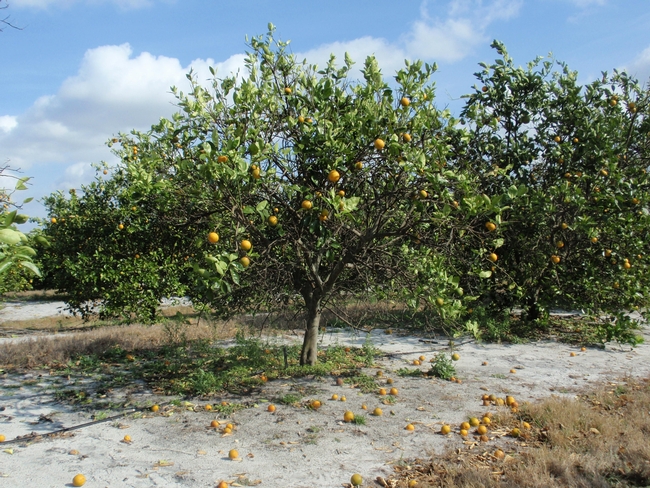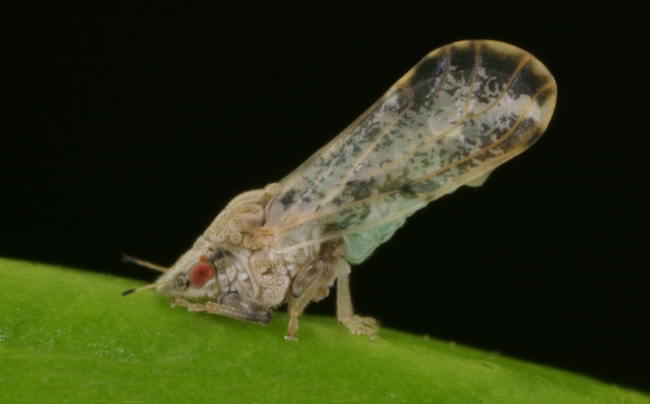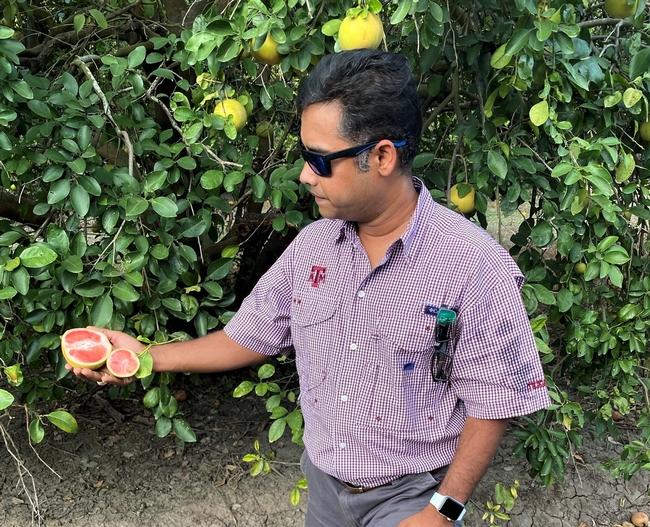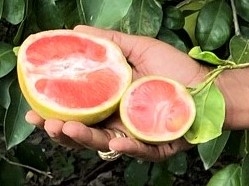Posts Tagged: citrus greening
Citrus threat target of $7 million multistate research project
UC ANR part of team led by Texas A&M AgriLife combating huanglongbing disease
Citrus greening, or huanglongbing disease (HLB), is the most devastating disease for orange and grapefruit trees in the U.S. Prevention and treatment methods have proven elusive, and a definitive cure does not exist.
Since HLB was detected in Florida in 2005, Florida's citrus production has fallen by 80%. Although there have been no HLB positive trees detected in commercial groves in California, more than 2,700 HLB positive trees have been detected on residential properties in the greater Los Angeles region.
“It is likely only a matter of time when the disease will spread to commercial fields, so our strategy in California is to try to eradicate the insect vector of the disease, Asian citrus psyllid,” said Greg Douhan, University of California Cooperative Extension citrus advisor for Tulare, Fresno and Madera counties.
Now, a public-private collaborative effort across Texas, California, Florida and Indiana will draw on prior successes in research and innovation to advance new, environmentally friendly and commercially viable control strategies for huanglongbing.
Led by scientists from Texas A&M AgriLife Research, the team includes three UC Agriculture and Natural Resources experts: Douhan; Sonia Rios, UCCE subtropical horticulture advisor for Riverside and San Diego counties; and Ben Faber, UCCE advisor for Ventura, Santa Barbara and San Luis Obispo counties.
$7 million USDA project
The $7 million, four-year AgriLife Research project is part of an $11 million suite of grants from the U.S. Department of Agriculture National Institute of Food and Agriculture, NIFA, to combat HLB. The coordinated agricultural project is also a NIFA Center of Excellence.
“Through multistate, interdisciplinary collaborations among universities, regulatory affairs consultants, state and federal agencies, and the citrus industry, we will pursue advanced testing and commercialization of promising therapies and extend outcomes to stakeholders,” said lead investigator Kranthi Mandadi, an AgriLife Research scientist at Weslaco and associate professor in the Department of Plant Pathology and Microbiology at the Texas A&M College of Agriculture and Life Sciences.
The UC ANR members of this collaboration will be responsible for sharing findings from the research with local citrus growers across Southern California, the desert region, the coastal region and the San Joaquin Valley.
“In addition to the ground-breaking research that will be taking place, this project will also help us continue to generate awareness and outreach and share the advancements taking place in the research that is currently being done to help protect California's citrus industry,” said Rios, the project's lead principal investigator in California.
Other institutions on the team include Texas A&M University-Kingsville Citrus Center, University of Florida, Southern Gardens Citrus, Purdue University and USDA Agricultural Research Service.
“This collaboration is an inspiring example of how research, industry, extension and outreach can create solutions that benefit everyone,” said Patrick J. Stover, vice chancellor of Texas A&M AgriLife, dean of the Texas A&M College of Agriculture and Life Sciences and director of Texas A&M AgriLife Research.
HLB solutions must overcome known challenges
An effective HLB treatment must avoid numerous pitfalls, Mandadi explained.
One major problem is getting a treatment to the infected inner parts of the tree. The disease-causing bacteria only infect a network of cells called the phloem, which distributes nutrients throughout a tree. Starved of nutrients, infected trees bear low-quality fruits and have shortened lifespans.
Treatments must reach the phloem to kill the bacteria. So, spraying treatments on leaves has little chance of success because citrus leaves' waxy coating usually prevents the treatments from penetrating.
Second, while the bacteria thrive in phloem, they do not grow in a petri dish. Until recently, scientists wishing to test treatments could only do so in living trees, in a slow and laborious process.
Third, orange and grapefruit trees are quite susceptible to the disease-causing bacteria and do not build immunity on their own. Strict quarantines are in place. Treatments must be tested in groves that are already infected.
Two types of potential HLB therapies will be tested using novel technologies
The teams will be working to advance two main types of treatment, employing technologies they've developed in the past to overcome the problems mentioned above.
First, a few years ago, Mandadi and his colleagues discovered a way to propagate the HLB-causing bacteria in the lab. This method involves growing the bacteria in tiny, root-like structures developed from infected trees. The team will use this so-called “hairy roots” method to screen treatments much faster than would be possible in citrus trees.
“Even though a particular peptide may have efficacy in the lab, we won't know if it will be expressed in sufficient levels in a tree and for enough time to kill the bacteria,” Mandadi said. “Viruses are smart, and sometimes they throw the peptide out. Field trials are crucial.”
The second type of treatment to undergo testing is synthetic or naturally occurring small molecules that may kill HLB-causing bacteria. Again, Mandadi's team will screen the molecules in hairy roots. A multistate team will further test the efficacy of the most promising molecules by injecting them into trunks of infected trees in the field.
A feasible HLB treatment is effective and profitable
Another hurdle to overcome is ensuring that growers and consumers accept the products the team develops.
“We have to convince producers that the use of therapies is profitable and consumers that the fruit from treated trees would be safe to eat,” Mandadi said.
Therefore, a multistate economics and marketing team will conduct studies to determine the extent of economic benefits to citrus growers. In addition, a multistate extension and outreach team will use diverse outlets to disseminate project information to stakeholders. This team will also survey growers to gauge how likely they are to try the treatments.
“The research team will be informed by those surveys,” Mandadi said. “We will also engage a project advisory board of representatives from academia, universities, state and federal agencies, industry, and growers. While we are doing the science, the advisory board will provide guidance on both the technical and practical aspects of the project.”
Project team members:
—Kranthi Mandadi, Texas A&M AgriLife Research.
—Mike Irey, Southern Gardens Citrus, Florida.
—Choaa El-Mohtar, University of Florida Institute of Food and Agricultural Sciences, Citrus Research and Education Center.
—Ray Yokomi, USDA-Agricultural Research Service, Parlier, California.
—Ute Albrecht, University of Florida IFAS Southwest Florida Research and Education Center.
—Veronica Ancona, Texas A&M University-Kingsville Citrus Center.
—Freddy Ibanez-Carrasco, Texas A&M AgriLife Research, Department of Entomology, Weslaco.
—Sonia Irigoyen, AgriLife Research, Texas A&M AgriLife Research and Extension Center at Weslaco.
—Ariel Singerman, University of Florida IFAS Citrus Research and Education Center.
—Jinha Jung, Purdue University, Indiana.
—Juan Enciso, Texas A&M AgriLife Research, Department of Biological and Agricultural Engineering, Weslaco.
—Samuel Zapata, Texas A&M AgriLife Extension, Department of Agricultural Economics, Weslaco.
—Olufemi Alabi, Texas A&M AgriLife Extension, Department of Plant Pathology and Microbiology, Weslaco.
—Sonia Rios, University of California Cooperative Extension, Riverside and San Diego counties.
—Ben Faber, University of California Cooperative Extension, Ventura, Santa Barbara and San Luis Obispo counties.
—Greg Douhan, University of California Cooperative Extension, Tulare, Fresno and Madera counties.
Invasive meltdown
Ants can be a huge nuisance in and outside our homes, particularly if you have food lying around. But now, it turns out, they’re unwelcome, too, on citrus trees.
A year ago, UC Riverside entomologists released Tamarixia, a parasitoid wasp and natural enemy of the Asian citrus psyllid (ACP) imported from Pakistan, into a biocontrol grove in Riverside, Calif. Tamarixia can serve as an excellent biocontrol agent against ACP, a citrus pest first detected in 2008 in Southern California that is capable of spreading citrus greening disease, or Huanglongbing.
Tamarixia’s success starts with a female laying an egg on the underbelly of an ACP nymph. When the egg hatches, the parasitoid larva will scrape away the nymph’s belly, carving out a hole to push through to enter the nymph’s body. Feeding on the contents, the larva eventually excavates the entire nymph, leaving only a shell or husk of the nymph behind.
Female Tamarixia can kill psyllids also by “host-feeding.” They use their ovipositors as daggers to stab psyllid nymphs numerous times until the nymphs start to bleed. As bodily fluids ooze out of the nymph, Tamarixia sucks up this rich protein needed for developing more eggs.
An excellent way then to control ACP populations! Yes, but only until the ants come marching in. Argentine ants are threatening to disrupt the biocontrol of ACP by battling it out with Tamarixia on citrus branches. While not quite a Vader-Skywalker lightsaber duel on a precarious walkway, an “invasive meltdown” begins when the ants gang up to protect the nymphs.
“ACP nymphs produce a white, sugary waste product called honeydew, a good carbohydrate source for the ants,” explains Mark Hoddle, the director of the Center for Invasive Species Research at UC Riverside, whose research team has released Tamarixia into several Southern California citrus groves. “The ants, therefore, will protect the nymphs from Tamarixia. We have seen ants chase female Tamarixia off the psyllids, and even catch and eat them!”
“If you kill off the ants, Tamarixia can play the role of the biocontrol agent it was cast to do on citrus trees,” Hoddle says. “We’re seeing that the ants are impacting Tamarixia in two ways: they are preventing Tamarixia’s establishment in some areas; and, where Tamarixia is already established, the ants are not allowing these parasitoids to reach their full biocontrol potential.”
USDA to provide $11 million for citrus greening research
The USDA will provide $11 million for scientific research to battle citrus greening disease, according to a USDA news release issued this morning. Citrus greening disease is spread by the Asian citrus psyllid, which made its way to California in 2008. When a tree acquires the disease from the pest, nutrient flow is obstructed, the fruit stays green, grows lopsided and tastes bitter.
USDA will invest $2 million this year for research at the U.S. Horticultural Research Laboratory in Ft. Pierce, Fla. The remaining $9 million will be offered in a three-year competitive grants program by the agency's National Institute of Food and Agriculture.
The news release said USDA will also establish a Citrus Disease Research and Development Advisory Committee with representatives from the grower and scientific communities. The advisory committee, which reports to U.S. agriculture secretary Tom Vilsack, will provide leadership to citrus disease scientists.
Citrus greening is one of the most devastating diseases affecting any commercial agricultural crop, according to the National Academy of Sciences. More than 250,000 jobs representing key sectors of the U.S. economy are at risk, including harvesting, packaging, processing, transportation, marketing, retail sales, and nursery production.
Citrus greening threatens to destroy over 1 million commercial citrus acres that have an annual production value of approximately $3 billion across the nation. Yearly losses could reach $10 billion if citrus greening is left unchecked.
Asian citrus psyllid was first detected in California in San Diego and Imperial counties. The pest is believed to have been introduced from northern Mexico. Adult psyllids have also been trapped in Orange, Los Angeles and Ventura counties. The University of California, California Department of Food and Agriculture, USDA and the citrus industry are working closely to quarantine the affected areas and try to eradicate the pest.
The state of Florida first detected the Asian citrus psyllid in 1998 and citrus greening disease seven years later. The pest and disease have been detected in all 30 of Florida's citrus producing counties and in Louisiana, Georgia and South Carolina. The states of Texas, Mississippi and Alabama, like California, have detected the pest but not the disease.
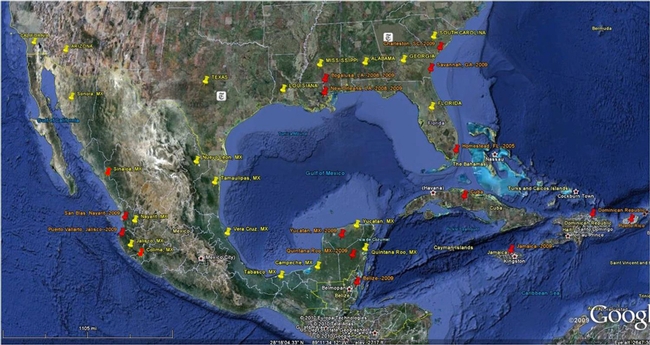
Red pins on the Texas Department of Agriculture map show where citrus greening disease has been found. Yellow pins show where Asian citrus psyllid has been found.
Genetic modification may be only way to save citrus industry
Genetic modification is the best long-term hope for the citrus industry when faced with huanglongbing disease, according to a Reuters special report, however, opposition to so-called "Frankenfood" is expected.
Reuters centered its story in Florida, where huanglongbing, or citrus greening disease, was first identified in 2005. The devastating citrus disease is spread by Asian citrus psyllid (ACP), which made it's way into the Sunshine State in 1998.
Asian citrus psyllid was found in California in 2008; to date huanglongbing has not been found. The psyllid attacks leaves and stems of citrus, injecting a toxin when it feeds that causes leaves to twist and die. But the real threat is huanglongbing (HLB), "yellow dragon disease."
HLB can kill a citrus tree within 3 to 5 years, and there is no known cure. Once a tree is infected with HLB, the only way to prevent its spread is to remove and destroy the infected tree.
In the short-term growers are increasingly relying on pesticides to keep ACP at bay, the article said. The practice carries the risk of insects developing pesticide resistance, groundwater contamination and disruption of an integrated pest management program that depends on beneficial insects.
The biotech industry and geneticists in particular are making an all-out push to develop an effective weapon against greening, such as citrus trees genetically modified to be resistant to HLB. USDA scientist Calvin Arnold told the reporters he believes the general public is likely to accept GMO orange juice.
"I think especially here in the U.S., they're understanding transgenics a lot better. Just like people go to Taco Bell, they know they're eating crops that have been produced transgenically," Arnold was quoted.
For more on Asian citrus psyllid in California, see the UC Kearney Agricultural Center Citrus Entomology website.
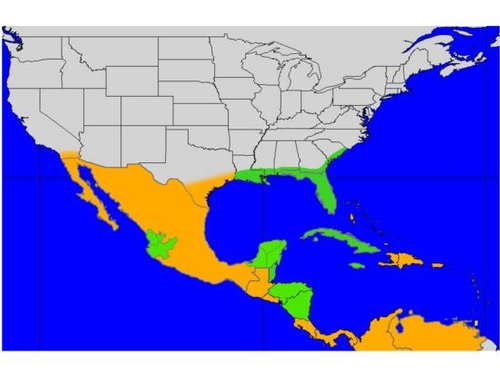
North American distribution of ACP is in orange; areas with ACP and HLB are in green.
Disease watch
The Asian citrus psyllid's border crossing into San Diego County earlier this month is prompting an emotional reaction from growers. Called the "mother of all killer bugs" by Fresh Plaza, the psyllid is most feared for its ability to spread citrus greening disease.
Farmers' comments in a story that appeared in North (San Diego) County Times reflect their dismay.
- "Honestly, I don't even want to know I have the pest. Because once I know I have the pest, it's all over. I might as well throw in the towel. Honestly, I don't see any way of stopping it. What are you going to do? Tent 80 acres?" - Bob Polito, a Valley Center grower and owner of Polito Family Farms.
- "The only remedy for a plant is to take a chain saw to it so it doesn't become a point of infection for the rest of the crops." - San Diego County's agriculture commissioner, Bob Atkins.
- "It's getting to a point where it just pushes out the domestic farmer." - Ben Drake, owner of Drake Enterprises iin Temecula.
Meanwhile, a UC Riverside graduate student has discovered and named a new bacterial pathogen that could be responsible for a devastating condition in tomatoes called "psyllid yellows," according to a story in Capital Press. The bacterium could be linked to the pathogen that causes citrus greening disease.

